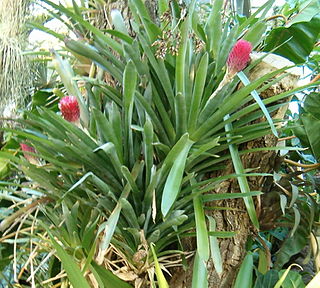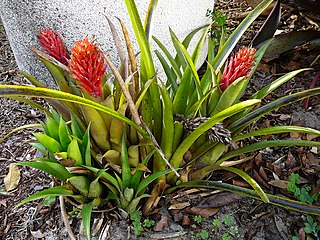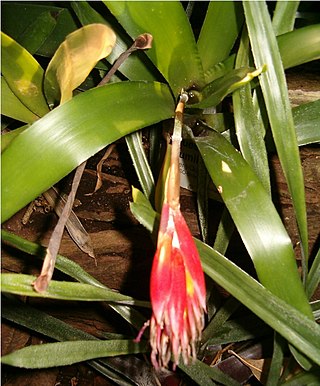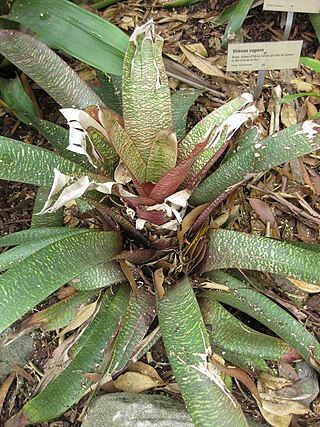
Quesnelia is a genus of flowering plants in the family Bromeliaceae, subfamily Bromelioideae. The genus is named after French businessman and patron of botany Edouard Prosper Quesnel, of Le Havre (1781–1850). Endemic to eastern Brazil, this genus contains 22 known species. This genus has two recognized subgenera: the type subgenus and BillbergiopsisMez.

Quesnelia marmorata is a species of flowering plant in the family Bromeliaceae, endemic to the Atlantic Forest ecoregion of southeastern Brazil. It was first described by Charles Antoine Lemaire in 1855 as Billbergia marmorata.

Quesnelia testudo is a species of bromeliad in the genus Quesnelia.

Portea alatisepala is a plant species in the genus Portea.

Quesnelia edmundoi is a species of flowering plant in the family Bromeliaceae, endemic to Brazil. It was first described by Lyman Bradford Smith in 1851. It is found in the Atlantic Forest ecoregion only within Rio de Janeiro state, in southeastern Brazil.

Nidularium procerum is a species of bromeliad in the genus Nidularium.
Nidularium scheremetiewii is a species of bromeliad in the genus Nidularium.

Neoregelia concentrica is a species of bromeliad in the genus Neoregelia. This species is endemic to Brazil.

Quesnelia arvensis is a species of bromeliad in the genus Quesnelia.
Quesnelia augustocoburgii is a species of flowering plant in the family Bromeliaceae, endemic to Brazil. It was first described by Heinrich Wawra von Fernsee in 1880. It is found in the Atlantic Forest ecoregion of southeastern Brazil. The name is sometimes spelt with a hyphen as Quesnelia augusto-coburgii.
Quesnelia dubia is a species of flowering plant in the family Bromeliaceae, endemic to Brazil. It was first described in 2005. It is found in the Atlantic Forest ecoregion in southeastern Brazil.

Quesnelia humilis is a species of flowering plant in the family Bromeliaceae, endemic to Brazil. It was first described by Carl Christian Mez in 1892. It is found in the Atlantic Forest ecoregion of south and southeastern Brazil.
Quesnelia imbricata is a species of flowering plant in the family Bromeliaceae, endemic to Brazil. It was first described by Lyman Bradford Smith in 1952. It is found in the Atlantic Forest ecoregion of southeastern Brazil.
Quesnelia indecora is a species of flowering plant in the family Bromeliaceae, endemic to Brazil. It was first described by Carl Christian Mez in 1892. It is found in the Atlantic Forest ecoregion of southeastern Brazil.
Quesnelia kautskyi is a species of flowering plant in the family Bromeliaceae, endemic to Brazil. It was first described in 1999. It is found in the Atlantic Forest ecoregion of southeastern Brazil.

Quesnelia liboniana is a species of flowering plant in the family Bromeliaceae, endemic to southeastern Brazil. It was first described in 1851 as Billbergia liboniana. It is found in the Atlantic Forest ecoregion of southeastern Brazil.

Quesnelia seideliana is a species of flowering plant in the family Bromeliaceae, endemic to Brazil. It was first described in 1963. It is found in the Atlantic Forest ecoregion within Rio de Janeiro state, in southeastern Brazil.
Quesnelia blanda is a species of flowering plant in the family Bromeliaceae, endemic to southeastern Brazil. It was first described in 1856 as Bromelia blanda. As of November 2022, the Encyclopaedia of Bromeliads listed it under the synonym Quesnelia strobilospica, which it spelt Quesnelia strobilispica.

Vriesea bituminosa is a plant species in the genus Vriesea, endemic to Brazil and Venezuela.

Vriesea vagans is a plant species in the genus Vriesea. The bromeliad is endemic to the Atlantic Forest biome, located in southeastern Brazil.













